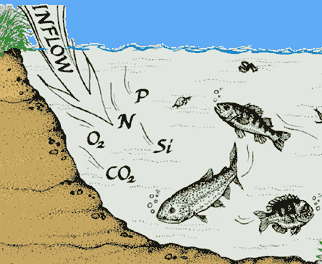AQUATOX
Linking water quality and aquatic life

AQUATOX models the fate of various pollutants and how they affect aquatic life.
AQUATOX is a simulation model for aquatic systems. AQUATOX predicts the fate of various pollutants, such as nutrients and organic chemicals, and their effects on the ecosystem, including fish, invertebrates, and aquatic plants. This model is a valuable tool for ecologists, biologists, water quality modelers, and anyone involved in performing ecological risk assessments for aquatic ecosystems. Although incorporating constructs from classic ecosystem and chemodynamic models, AQUATOX was developed from the beginning as an applied model for use by environmental analysts.
An updated version of Release 3.1 of AQUATOX is now available. Release 3.1 contains several enhancements over previous releases that improve the model's interface and utility. For example, the sediment diagenesis model has a "steady-state" mode that increases model speed dramatically. Other categories of refinements include floating-plants refinements, bioaccumulation and toxicity modeling improvements, and improved sensitivity and uncertainty analyses.
The new updates to Release 3.1 include an option to model nutrient limitation in plants based on internal rather than external nutrients, which should improve the prediction of the timing and duration of algal blooms. Among the other enhancements in the update is the output of additional ecological metrics such as net primary productivity and fish biomass.
AQUATOX Release 2 underwent an external peer review in late 2003. Release 3 underwent external peer review in late 2008.
- What's new in Release 3.1 and Release 3.1 Plus?
- Basic Information
- What does AQUATOX do?
- Training - classes and downloadable presentation materials
- Frequently Asked Questions
- AQUATOX Email Listserv
- Peer Review
- Publications About or Referencing AQUATOX
- AQUATOX Supporting Documentation
- Modeling Periphyton with AQUATOX
- Download the model
- Data sources
| Version | Release Date |
|---|---|
| Release 3.1 Plus | May 2014 |
| Release 3.1 | late 2013 |
| Release 2 | late 2003 |
| Release Notes | |
Contact
For questions about AQUATOX you may contact Brenda Rashleigh (rashleigh.brenda@epa.gov), Atlantic Ecology Division, Office of Research and Development, 27 Tarzwell Drive, Narragansett, RI 02882 (phone: 401-782-3014).
